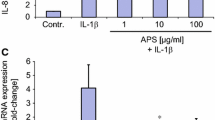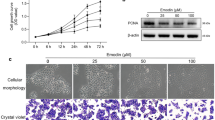Abstract
Acne is a complex, chronic and common skin disorder of pilosebaceous units. Hyperkeratinization of keratinocytes, increased sebum excretion from sebocytes via androgen stimulation and inflammatory cytokines are the major factors involved in the pathophysiology of acne. In addition, it is known that keratinocytes play an important role in acne synthesizing a number of inflammatory cytokines. However, the nature of the association between inflammatory cytokines and sebocytes in acne remains unclear. Culture of sebocytes provides a new insight into the participation of dihydrotestosterone (DHT) in the production of inflammatory cytokines in acne. To examine the possible involvement of DHT in the production of inflammatory cytokines in the cultured sebocytes, we used immunohistochemistry and RT-PCR to compare the expression of interleukin-1 (IL-1), IL-6, tumor necrosis factor-α (TNF-α). Upregulation of IL-6 and TNF-α in immunohistochemistry, and increase in RNA amplification for IL-6 and TNF-α were observed after addition of DHT compared with the control. This study suggests that DHT may not only be involved in sebum production but also in production of proinflammatory cytokines in acne.




Similar content being viewed by others
References
Akamatsu H, Zouboulis CC, Orfanos CE (1992) Control of human sebocyte proliferation in vitro by testosterone and 5-α-dihydrotestosterone is dependent on the localization of the sebaceous glands. J Invest Dermatol 99:509–511
Choudhry R, Hodgins MB, Van der Kwast TH, Brinkmann AO, Boersma WJ (1992) Localization of androgen receptors in human skin by immunohistochemistry: implications for the hormonal regulation of hair growth, sebaceous glands and sweat glands. J Endocrinol 133:467–475
Cunliffe WJ (1989) Acne. Martin Dunitz, London
Fujie T, Shikiji T, Uchida N, Urano Y, Nagae H, Arase S (1996) Culture of cells derived from the human sebaceous glands under serum-free conditions without a biological feeder layer or specific matrices. Arch Dermatol Res 288:703–708
Gonzales RJ, Duckles SP, Krause DN (2009) Dihydrotestosterone stimulates cerebrovascular inflammation through NFκB, modulating contractile function. J Cereb Blood Flow Metab 28:244–253
Guy R, Green MR, Kealey T (1996) Modeling acne in vitro. J Invest Dermatol 106:176–182
Köch A, Schwarz T, Kirnbauer R, Urbanski A, Perry P, Ansel JC et al (1990) Human keratinocytes are a source for tumor necrosis factor α: evidence for synthesis and release upon stimulation with endotoxin or ultraviolet light. J Exp Med 172:1609–1614
Lee WJ, Jung HD, Lee HJ, Kim BS, Lee SJ, Kim DW (2008) Influence of substance-P on cultured sebocytes. Arch Dermatol Res 300:311–316
Luger TA, Schwarz T (1990) Evidence for an epidermal cytokine network. J Invest Dermatol 95:1005–1011
Mercurio MG, Gogstetter DS (2000) Androgen physiology and the cutaneous pilosebaceous unit. J Gend Specif Med 3:59–64
Nelson AM, Thiboutot DM (2008) Biology of sebaceous glands. In: Wolff K et al (eds) Fitzpatrick’s dermatology in general medicine, 7th edn. McGraw-Hill, New York, pp 687–690
Partridge M, Chantry D, Turner M, Feldmann M (1991) Production of IL-1 and and IL-6 by human keratinocytes and squamous cell carcinoma cell lines. J Invest Dermatol 96:771–776
Sansone G, Reiser RM (1971) Differential rates of conversion of testosterone to dihydrotestosterone in acne and in normal human skin—a possible pathogenic factor in acne. J Invest Dermatol 56:366–372
Singer KH, Tuck DT, Sampson HA, Hall RP (1989) Epidermal keratinocytes express the adhesion molecule intercellular adhesion molecule-1 in inflammatory dermatoses. J Invest Dermatol 93:746–750
Strauss JS, Kligman AM, Pochi PE (1962) The effect of androgens and estrogens on human sebaceous glands. J Invest Dermatol 39:139–155
Webster GF (2005) The pathophysiology of acne. Cutis 76:4–7
Winston MH, Shalita AR (1991) Acne vulgaris. Pathogenesis and treatment. Pediatr Clin North Am 38:889–903
Zouboulis CC (2004) Acne and sebaceous gland function. Clin Dermatol 22:360–366
Zouboulis CC, Chen WC, Thornton MJ, Qin K, Rosenfield R (2007) Sexual hormones in human skin. Horm Metab Res 39:85–95
Zouboulis CC, Xia L, Akamatsu H, Seltmann H, Fritsch M, Hornemann S et al (1998) The human sebocyte culture model provides new insights into development and management of seborrhea and acne. Dermatology 196:21–31
Zouboulis CC, Xia L, Detmar M, Bogdanoff B, Giannakopoulos G, Gollnick H et al (1991) Culture of human sebocytes and markers of sebocytic differentiation in vitro. Skin Pharmacol 4:74–83
Conflict of interest statement
The authors declare that they have no conflict of interest.
Author information
Authors and Affiliations
Corresponding author
Rights and permissions
About this article
Cite this article
Lee, W.J., Jung, H.D., Chi, S.G. et al. Effect of dihydrotestosterone on the upregulation of inflammatory cytokines in cultured sebocytes. Arch Dermatol Res 302, 429–433 (2010). https://doi.org/10.1007/s00403-009-1019-6
Received:
Revised:
Accepted:
Published:
Issue Date:
DOI: https://doi.org/10.1007/s00403-009-1019-6




